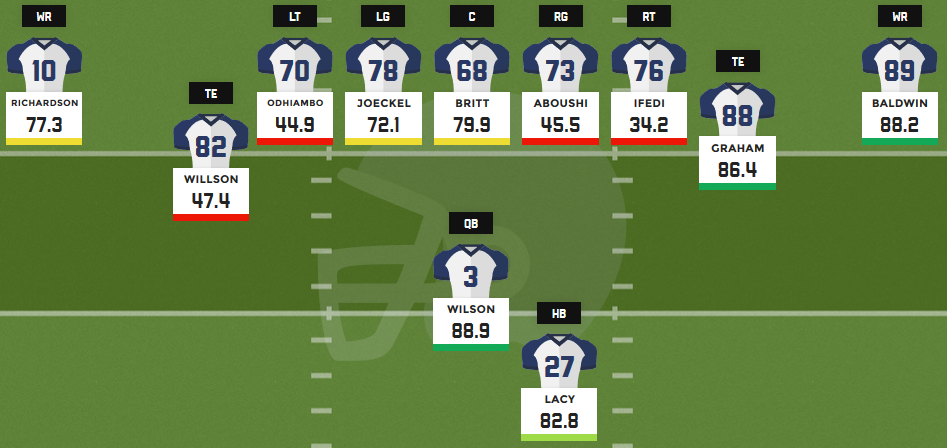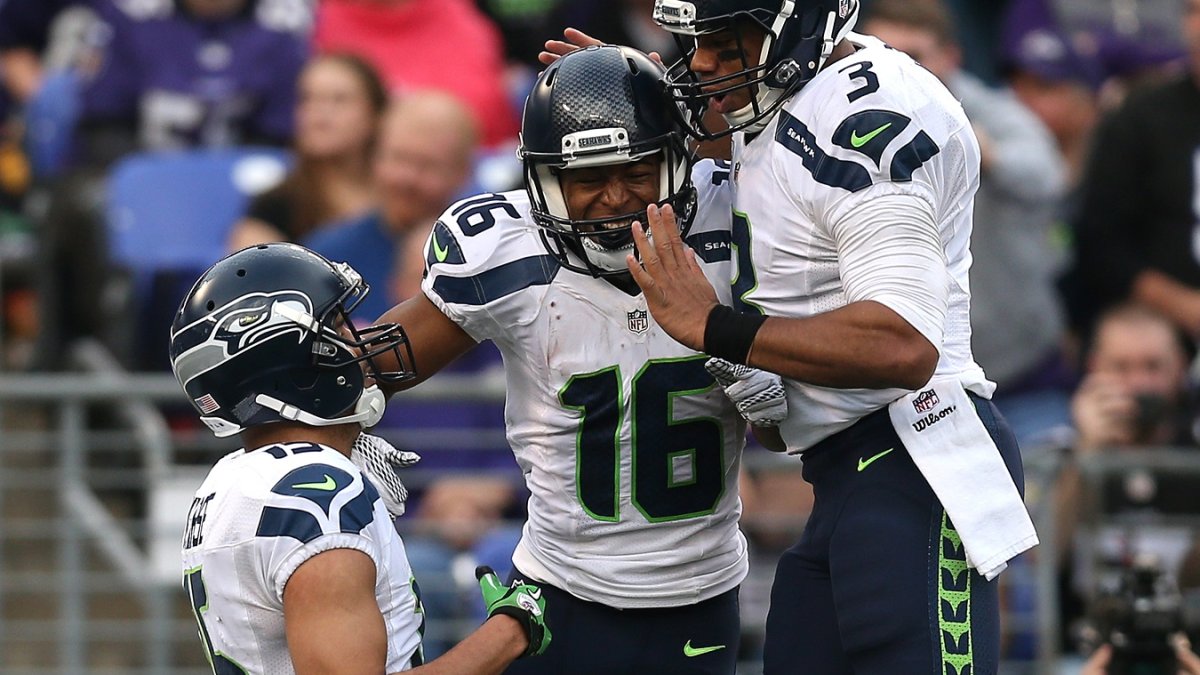From a fantasy perspective, the Seahawks were a modest disappointment in 2016, but that can largely be attributed to Russell Wilson’s lingering ankle injury. He’s fully healthy now, and the Seahawks should be all systems “go” for 2017. Their offense is mostly the same, save for the addition of Eddie Lacy, who figures to lead the team in rushing attempts while simultaneously creating a confusing, busy backfield for fantasy purposes.
|
Team Offensive Stats |
|||
| SEA | Rank | Lg Avg | |
| Snaps/Gm | 65.8 | 15 | 65.3 |
| Pace (Sec/Sn) | 23.88 | 10 | 24.28 |
| Run % | 38.3% | 22 | 39.8% |
| Pass % | 61.7% | 11 | 60.2% |
| % Leading | 42.8% | 8 | 36.0% |

Quarterback
As noted above, Wilson was a disappointment in 2016, and it actually sunk Seattle’s fantasy prospects as a whole. But it’s a rosy picture for 2017, with Wilson projected to be a top-five fantasy quarterback again. We have Wilson projected for a position-high 82 rushing attempts, which would go a long way toward boosting his fantasy value.
The biggest issue is Wilson’s protection. As you can see in the above image, nobody on Seattle’s offensive line stands out as a stalwart protector. Wilson was under pressure on 41.6 percent of his attempts last season — the third-highest rate in the league. Keeping Wilson healthy is vital to Seattle’s success, and it’s also vital to Seattle’s worth to the fantasy community. Unfortunately, given his offensive line, it’s not a sure thing.
|
Vacated Touches |
||
| 2016 Touches | % Vacated | |
| Carries | 341 | 37.2% |
| Targets | 511 | 9.0% |
| Total | 852 | 20.3% |
Running back
Seattle has a new-look backfield thanks to the addition of Lacy. As you can see, the team left a large amount of carries on the table (37.2 percent vacated) for this year, and Lacy figures to scoop all of them up — and then some. Don’t forget: We’re just a few years removed from Lacy going in the top five of most fantasy drafts. He was also decent in limited time last year, averaging a strong 3.41 average yards after contact en route to a PFF elusive rating of 95.4, second-best among all running backs who saw at least 40 rushing attempts.
But Lacy’s issue has been durability. After gaining at least 1,100 yards on at least 245 attempts his first two years in the league, he hasn’t top 190 attempts or 800 yards in his last two. The Seahawks also have promising younger players like Chris Carson, C.J. Prosise, and Thomas Rawls on the roster, so Lacy probably won’t be a true workhorse as the team feeds these other mouths.
Prosise will mix in a good amount in the passing game, and he carries fringe flex appeal in PPR formats as a result. He displayed some three-down chops in limited time last year, but with the other rushers on the roster, he’s lining up to be more of a pass-catching specialist this year.
Carson is everyone’s favorite “sleeper” leading into 2017, but he has some ways to go before seeing enough volume to perform in fantasy. However, he did split time with the first team fairly evenly with Lacy during the preseason, so there’s reason to believe.
Rawls is the trickiest one to figure out. He has the longest track record with Seattle, but he’s less established in the league than Lacy, he’s not as good through the air as Prosise, and he’s not as enticing as Carson. So where does he fit?
This has backfield-by-committee written all over it, with Lacy as the early-season favorite to lead the charge. However, any one of these four players could feasibly be the team’s highest-scoring player at the position by season’s end.
|
Rushing Stats |
|||
| SEA | Rank | Lg Avg | |
| YPC | 3.97 | 23 | 4.18 |
| YCo/Att | 2.11 | 28 | 2.43 |
| YBCo/Att | 1.86 | 11 | 1.76 |
| Inside Zone | 44.9% | 2 | 26.0% |
| Outside Zone | 20.6% | 22 | 27.7% |
| Power | 13.4% | 15 | 9.5% |
| Man | 1.0% | 32 | 15.0% |
Wide receivers
The Seahawks have long had a confusing group of wideouts from a fantasy perspective, and 2017 will be no different. Doug Baldwin is an obvious tail-end WR1 for fantasy, but beyond him, it’s anyone’s guess.
Seattle traded Jermaine Kearse to the Jets, so Paul Richardson will start the season as the Seahawks’ No. 2 wideout. The former second-round pick caught on down the stretch last season, hauling in eight of 12 targets for 82 yards and a score over the team’s final two games of the year, before adding another seven receptions for 131 yards and a touchdown in the playoffs. He’s a name to watch.
Tyler Lockett is also still in Seattle, and we’re just one year removed from everyone labeling him as a potential breakout player. He caught 41 of 62 passes for 597 yards last year, but he had just one touchdown despite the fact he was often targeted in or near the end zone. Lockett will see some positive touchdown regression this year, and he’s a safe bet to end the year with somewhere between three and five scores. However, he’s still just a bye week flex fill-in.
The only other two wideouts on Seattle’s roster are Tanner McEvoy and Amara Darboh, neither of whom will factor into the fantasy discussion, barring an injury or two.
|
Wide Receiver Sets |
||||||
| % | Rank | Lg Avg | Throw% | Rk | Lg Avg | |
| 2-Wide | 24.0% | 17 | 24.5% | 41.1% | 22 | 45.0% |
| 3-Wide | 55.1% | 17 | 55.5% | 65.7% | 19 | 66.1% |
| 4-Wide | 2.2% | 10 | 2.9% | 87.0% | 16 | 81.6% |
Tight end
Jimmy Graham leads the way for Seattle’s group of tight ends. Graham is solidified as a TE1 for fantasy purpose, although he’s no longer in the upper-echelon with the likes of Rob Gronkowski, Travis Kelce, Greg Olsen, and Jordan Reed.
Graham had a somewhat underrated 2016, however, as he caught 65 of 93 targets for 923 yards and six touchdowns. It was his best season since 2013. It will be tough for him to match those yardage figures in 2017, but a 60-700-6 line is in the cards.
|
Personnel Groupings |
||||||
| % | Rank | Lg Avg | Throw% | Rk | Lg Avg | |
| 11 | 53.5% | 16 | 53.5% | 66.4% | 19 | 33.5% |
| 12 | 17.3% | 12 | 15.6% | 44.5% | 20 | 50.2% |
| 21 | 5.4% | 17 | 6.9% | 33.3% | 23 | 62.5% |
(Keep up with all of PFF Fantasy’s draft strategy and advice here!)




 © 2025 PFF - all rights reserved.
© 2025 PFF - all rights reserved.